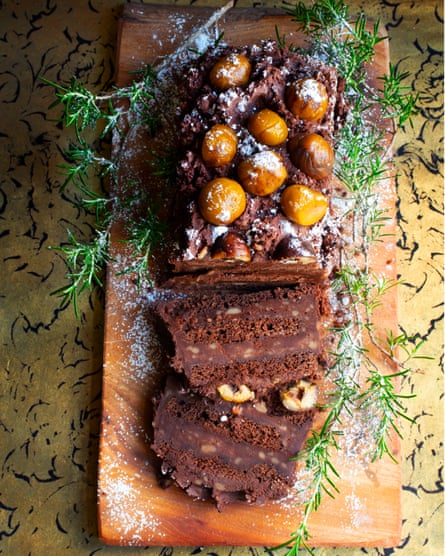
Chestnuts are here: dark, plump and shiny – and flat on one side from where they have snuggled together in their spiky green cases. Sweet chestnuts grew in the woods near my childhood home. I’d squirrel them away in my duffel-coat pockets on the walk home from school. We roasted them over the fire, the occasional one cracking like a whip, sending out a spray of nut shrapnel.
Better, I think, is to roast them in an oven. A deep cross on their rounded side will stop them exploding and expose their flesh to the heat. This is how I cook them for eating as they are, not worrying about removing the brown skin. They are hard work, though, if you intend to purée them or use them in a dessert. I always turn to the ready-made purée and vacuum-packed whole nuts. They can be folded into a Christmas nut loaf, tossed with the aromatics of a pot-roast bird or into the filling of a chocolate tart or cake.
Chestnut purée may not be much to look at, but introduce enough icing sugar, meringue and melted chocolate and you have one of the world’s classic marriages. It saves a lot of work for the cook. I wait each year for new season’s marrons glacés, with their fudgy texture, hoar-frost coating and origami-style gold wrappers. I’m hoping for some in my stocking.
Chestnut leaves are long and slim with edges like the teeth of a saw, and are often used for wrapping goat’s cheese. You can bake one whole, in its leaf, then unwrap it and watch the molten cheese ooze out. You’ll need crisp toast on the side or slices of russet apple, toasted nuts and a cluster of bitter leaves.
Red leaves, warm cheese and chestnuts
Find the small cheeses wrapped in fig leaves for this if you can. Or use kitchen foil to wrap your cheeses instead. Serves 4
chestnuts 200g
goat’s cheeses 4, about 80g each in weight
treviso, radicchio and other red chicory 100g in total
pears 200g
beetroot 1, small and raw
red wine vinegar 2 tbsp
garlic 1 small clove
olive oil 3 tbsp
Dijon mustard 1 tsp
Cut a cross on each chestnut, then place them, in a single layer, in a roasting tin. Bake for 25 minutes at 180C/gas mark 4, until the exposed nut is pale gold, then remove from the oven, cover with a cloth and rest for 15 minutes. Remove the nuts from their shells – I am not too fussy about removing the brown skin – and crumble or chop into small pieces.
If your cheeses come with a fig leaf wrapping then all to the good. If not, place the cheeses on a piece of foil, wrap it loosely over them and scrunch the edges together. Bake them (they can share an oven with the chestnuts) for about 15 minutes until the cheese starts to ooze.
Make the dressing: peel and crush the garlic to a paste with a pinch of salt. Put the paste into a small bowl, pour in the vinegar and set aside for 10 minutes. Add the mustard to the vinegar, then beat in the olive oil with a fork.
Wash the leaves and tear into large pieces. Cut the pears into 4 or 6 pieces, depending on size – cut out and discard the cores. Peel and slice the beetroot. Toss the pears, beets and peeled chestnuts with the dressing and leave until the cheeses are ready.
Put the salad leaves on a serving dish, add the pears; trickle the dressing over the leaves. Place the molten cheese on top.
Chocolate chestnut cake
Offer this in thin slices, with a spoonful of chantilly cream at the side. Serves 8
For the cake:
butter 250g
caster sugar 225g
self-raising flour 225g
baking powder 1 tsp
cocoa powder 30g
eggs 4
milk 4 tbsp
hot espresso 4 tbsp
For the filling:
dark chocolate 250g
butter 100g
chestnut purée 400g
caster sugar 2 tbsp
To finish:
cooked chestnuts 100g
icing sugar 1 tbsp
You will need a square 20cm baking tin lined with baking parchment and a 20cm loaf tin for the cake.
Set the oven at 170C/gas mark 3. Cut the butter into dice, put into the bowl of a food mixer and add the caster sugar. Beat until soft and creamy. Break the eggs into a bowl, add the milk and beat lightly. Sift together the flour, baking powder and cocoa powder. Add the eggs to the creamed butter and sugar. If they start to curdle, add 1 heaped tbsp of the flour. Mix in the flour and cocoa, then the coffee. Stop the machine as soon as everything is combined.
Transfer the mixture to the square cake tin, lightly smooth the surface, then bake for 35 minutes until risen and springy to the touch. Remove and set aside to cool.
Make the filling: break the chocolate into small pieces, place them in a heatproof bowl, then balance it over a pan of simmering water. Leave the chocolate to melt without stirring. When it is completely melted, cut the butter into small pieces and add to the chocolate, lightly stirring, until it is melted. Mix the chestnut purée with the sugar and beat until smooth with a wooden spoon. Stir the purée into the melted chocolate.
Drape the rectangular loaf tin with clingfilm, push it into the corner and leave some overhanging the edges. Cut a slice of cake the length and width of the cake tin. Slice this into 3 horizontally, to give 3 thin strips. Place one in the base of the tin. Add a third of the chocolate chestnut mixture, smooth flat then place the second piece of cake on top and press firmly. Now add a second third of the chocolate mixture, the remaining piece of cake and then the final slice of cake.
Fold the clingfilm over the top of the tin and place in the fridge for 2 hours. Keep the remaining third of the mixture in its bowl over the hot water. (Although off the heat, the mixture will cool, but not set firmly.)
Turn the tin upside down and remove the cake. Spread the top with the reserved chocolate mix, then decorate with cooked chestnuts and dust with icing sugar.
Follow Nigel on Instagram @NigelSlater



